THIS IS AN ARCHIVED VERSION OF CRA'S WEBSITE. THIS ARCHIVE IS AVAILABLE TO PROVIDE HISTORICAL CONTENT.
PLEASE VISIT HTTP://WWW.CRA.ORG FOR THE LATEST INFORMATION
| About CRA |
| Membership |
| CRA for Students |
| CRA for Faculty |
| CRA-Women |
| Computing Community Consortium (CCC) |
| Awards |
| Projects |
| Events |
| Jobs |
| Government Affairs |
| Computing Research Policy Blog |
| Publications |
| Data & Resources |
| CRA Bulletin |
| What's New |
| Contact |
| Home |
<< Back to May 2005 CRN Table of Contents
See also CS Bachelor’s
Degree Production Grows in 2004; Poised for Decline and
Interest in CS as a Major
Drops Among Incoming Freshmen.
[Published originally in the May 2005 edition of Computing Research News, Vol. 17/No. 3]
2003-2004 Taulbee Survey
Record Ph.D. Production on the Horizon; Undergraduate Enrollments Continue in Decline
By Stuart Zweben
This article and the accompanying figures and tables present the results of the 34th annual CRA Taulbee Survey [1] of Ph.D.-granting departments of computer science (CS) and computer engineering (CE) in the United States and Canada. This survey is conducted annually by the Computing Research Association to document trends in student enrollment, employment of graduates, and faculty salaries.
The information was collected in the fall of 2004. Responses received by January 17, 2005 are included in the analysis. The period covered by the data varies from table to table. Degree production and enrollment (Ph.D., Master's, and Bachelor's) refer to the previous academic year (2003-04). Data for new students in all categories refer to the current academic year (2004-05). Projected student production and information on faculty salaries and demographics also refer to the current academic year. Faculty salaries are those effective January 1, 2005.
The data were collected from Ph.D.-granting departments only. A total of 229 departments were surveyed, four more than last year. As shown in Figure 1, 189 departments submitted their survey forms, for a response rate of 83% (the highest in the past ten years). The return rate of 10 out of 30 (33%) for Computer Engineering (CE) programs is very low, as has been customary. Many CE programs are part of an ECE department, and they do not keep separate statistics for CE vs. EE. In addition, many of these departments are unaware of the Taulbee Survey or its importance. The response rate for US CS departments (158 of 172, or 92%) was very good, while the 78% response rate for Canadian programs was moderately good.
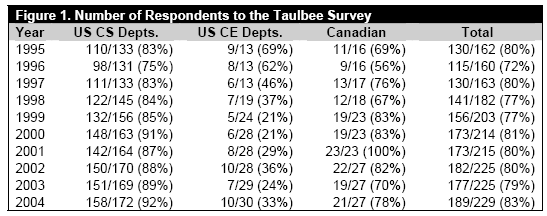
The set of departments responding varies slightly from year to year, even when the total numbers are about the same; thus, we must approach any trend analysis with caution. We must be especially cautious in using the data about CE departments because of the low response rate. However, we have reported CE departments separately because there are some significant differences between CS and CE departments.
The survey form itself is modified slightly each year to ensure a high rate of return (e.g., by simplifying and clarifying), while continuing to capture the data necessary to understand trends in the discipline and also reflect the changing concerns of the computing research community. In December 2004, preliminary survey results about faculty salaries were provided to departments that had responded. The CRA Board views this as a benefit of participating in the survey. This practice began last year and is expected to continue.
We thank all respondents who completed this year's questionnaire. The names of the departments that participated are listed at the end of this article.
Ph.D. Degree Production and Enrollments (Tables 1-8)
As shown in Table 1, a total of 1,032 Ph.D. degrees were awarded in 2004 by the 189 responding departments. This is an increase of more than 17% over last year, and represents the highest number of Ph.D.s produced in almost a decade. In previous Taulbee reports, we foresaw a large increase in Ph.D. production based on the growing number of students passing qualifier exams. It appears that this was the year the significantly increased degree production really materialized, even allowing for the increased number of departments reporting.
As in previous years, the prediction from last year's survey that 1,350 Ph.D. degrees would be awarded in 2004 was overly optimistic. The “optimism ratio,” defined as the actual over the predicted, was 0.76, a slight increase over last year. Based on previous experiences, next year's prediction of 1,480 graduates (Table 1) is likely to yield an actual production in the 1,100 range, and production may exceed the 1992 all-time annual Taulbee Survey record of 1,113 (see Figure 2).
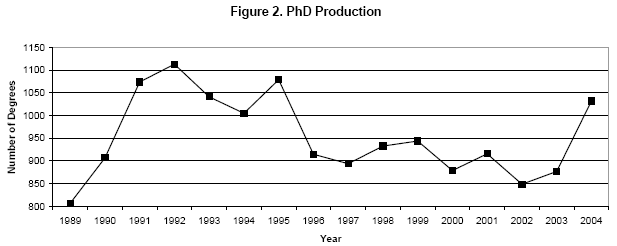
The number entering Ph.D. programs (Table 5) decreased from 3,131 to 2,887 (8%), following a 5% decrease last year. This year, the decrease is entirely in the U.S. programs, which exhibited no change in the size of the entering class last year. Canadian departments actually reported a 20% increase in new Ph.D. students after a drop last year, though Canadian numbers are more greatly affected by the specific departments responding to the survey than are the U.S. CS numbers. There were reports of a large drop in applications from international students last year, and this apparently also affected eventual admissions to the graduate programs. However, the number who passed qualifiers (Table 1) increased tremendously, from 1,545 to 2,318 (50%). On a per-department basis, the number passing qualifiers has risen from 6.5 to 12.3 (89%) in four years. The number who passed thesis proposal exams (Table 1) rose 16% this year to 1,025 after being flat last year. Total Ph.D. enrollment (Table 6) increased from 12,007 to 14,234 (19%), on the heels of a similar (20%) increase last year. While there are fewer new students entering the programs, those who are entering appear to be staying in much larger numbers than was the case several years ago. Economic conditions no doubt have a lot to do with this.
Figure 3 shows a longer-term trend of the number of CS Ph.D. graduates, normalized by the number of departments reporting to the Taulbee Survey. The figure also indicates the number of new students entering Ph.D. programs and the number of students who passed qualifiers. These also are normalized for the number of departments reporting. The graph offsets the qualifier data by one year from the data for new students, and offsets the graduation data by five years from the data for new students, to approximate the lag between student entrance into the pipeline and the qualifier and exit timeframe for the same cohort. The figure suggests that a much larger fraction of those entering the program are now passing qualifiers; the most recent data look more like the pre-dot-com boom years. Unless a larger fraction of those passing qualifiers do not complete the program, record levels of Ph.D. production can be expected soon.
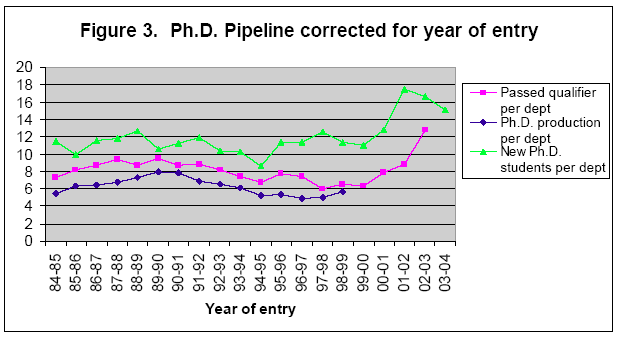
Table 4 shows employment for new Ph.D. recipients. Of those who reported employment domestically, 60% took academic employment (compared to 63% last year and 53% the year before). Most of these academic positions were in Ph.D.-granting departments, but a smaller percentage went into tenure-track positions (27.5% vs. 34.2% last year). Only 31 were in other CS/CE departments. This is identical to the number reported last year as having gone to non-Ph.D.-granting CS/CE departments. It still appears quite low relative to meeting the needs of those departments. There was a considerable increase (from 89 to 122) in the number of postdoctoral positions taken by new Ph.D.s (up from 56 three years ago), although the total number of postdocs in the academic departments (295, see Table 17) actually fell slightly (from 312 last year). Figure 4 shows the trend of employment of new Ph.D.s to academia and industry, and the proportion of those going to academia who took positions other than in Ph.D-granting CS/CE departments. The trend in favor of academic jobs during the most recent three years is in sharp contrast to that of the dot-com boom years, though this year there was a slight narrowing of the gap.
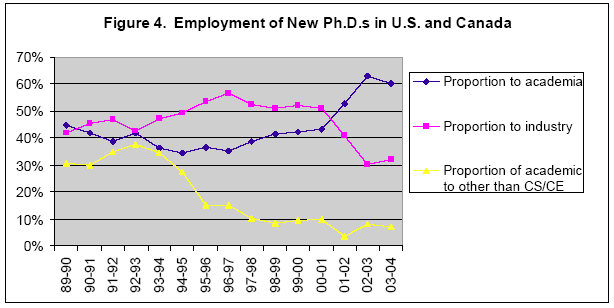
The proportion (4.5%) of Ph.D. graduates who were reported as having taken positions abroad, among those whose employment is known, is similar to that of the previous three years (4.1, 4.5, and 4.1%, respectively). Unless there really is a change hidden in the much larger number of those in the “employment unknown” category (206 this year vs. 126 last year), this lack of a trend may surprise those who feel that the offshoring of jobs is taking many more graduates of our Ph.D. programs away from North America.
The data in Table 4 also indicate increases over last year in the proportion of new CS/CE Ph.D.s in the AI/robotics, OS/networks, and software engineering areas, while the programming languages/compilers, theory/algorithms, numerical analysis/scientific computing, and database/information systems areas each experienced a decreased proportion of Ph.D.s. Multi-year trends are less clear, with only the graphics/HCI area showing any reasonably consistent trend (increasing) during the past five years.
Most statistics on gender and ethnicity for Ph.D. students (Tables 2, 3, 7, 8) again show little change from the last several years. White and nonresident-alien men continue to account for a very large fraction of our Ph.D. production and enrollments. The proportion of female Ph.D. graduates (18.0%) is up from the 16.5% figure last year. However, with women representing only about 20% of the overall Ph.D. enrollments, the proportion of female graduates is unlikely to climb considerably in the near future. All other underrepresented groups are very small minorities. The proportion of enrolled Ph.D. students who are nonresident aliens (more than 50%) is similar to last year. Thus, the reported decreases in Ph.D. applications from abroad and the decline in the total number of new Ph.D. students does not seem to have affected the overall demographics of the Ph.D. programs, at least not yet.

Master's and Bachelor's Degree Production and Enrollments (Tables 9-16)
The statistics on Master's and Bachelor's degrees awarded show mixed trends. Master's degrees were awarded to 9,879 students, an increase of 8% (following an increase of 15% the previous year). As was noted last year, this increase may be a byproduct of the increased enrollment trends in Ph.D. programs, since in many schools students obtain the M.S. on the way to the Ph.D. No doubt it is influenced also by the increase of 6% in the number of departments reporting this year. Actual masters degrees awarded exceeded last year’s projections by 21%. This year's expected Master's production (Table 12) exceeds the projection from last year's survey by 4%, but this also happened last year. In any case, next year’s production level may well exceed 10,000.
Bachelor's degrees numbered 20,971 (Table 9), a 5% increase over last year (following a 3% decrease the year before). There still appears to be residual influence of the high level of undergraduate program enrollment that began in the late 1990s and remained strong until the early 2000s. There also is the effect of the larger number of programs reporting this year. On a per-department basis, the number of Bachelor’s graduates is about the same as last year. Actual Bachelor’s production in departments reporting this year exceeded the projection from last year’s reporting departments by 11%. Projected Bachelor's production for this year shows a decrease from this year’s actuals of 6%, but this represents an increase over last year’s projections of 5%, probably again due in large part to the increased number of departments reporting (see Figure 6).
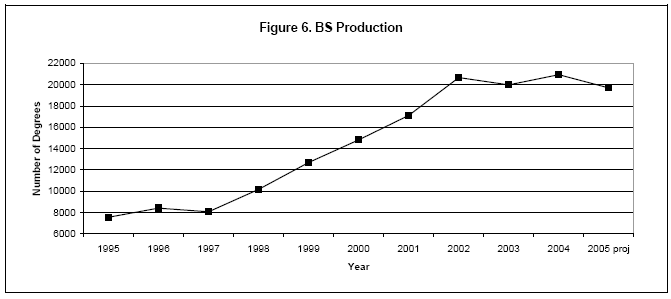
The number of new undergraduate majors dropped 10%, from 17,706 to 15,950, (see Figure 7). This follows last year’s 23% drop in new majors. The number of pre-majors in both computer science and computer engineering also is down considerably from last year (20% in CS and 17% in CE) so we likely have not yet seen the end of the decreased undergraduate enrollments. Also note that the larger number of departments reporting this year softens the impact on the totals, so the percentage declines in new majors and pre-majors likely are even greater. As Table 14 shows, per-department numbers are holding steady in CS departments ranked 1-12, but are down for all others. This trend has been reported extensively in the media during the past year.

New Master's students (Table 13) decreased by 17% after having decreased by 8% last year. This continues, and accelerates the trend from the dot-com crash, as fewer students seek degree programs designed mainly to prepare them for industry employment. Total enrollment in Bachelor's programs (Table 16) is approximately the same as it was last year (having dropped last year by 19% from the previous year). However, the U.S. CS total enrollment is down by 7%; this represents an increased number of reporting departments, so the downward trend appears to be continuing, as one might predict from the new student enrollment trends. Total enrollments in Master's programs (Table 15) increased by about 3% (having dropped by 4% last year), but the larger number of departments reporting probably counters this increase in numbers.
Most demographics regarding gender and ethnicity for Bachelor's and Master's students continue to be similar to those of previous years. The proportion of Master's degree recipients who are nonresident aliens (50.6%) is down from 55.8% the previous year, while there are slight gains in the fractions of White, non-Hispanic and Asian/Pacific Islanders (Table 10).
Faculty Demographics (Tables 17-23)
Over the past year, the total number of faculty increased by only 1.5% to a total of 5,919. Increases of 4% in tenure-track faculty and 5% in teaching faculty were offset by decreases in other categories, and also should be viewed in terms of the increased number of departments reporting this year.
Ph.D. production shows 461 graduates known to have taken faculty positions at CS/CE Ph.D-granting departments (Table 4). Tables 19 and 20 indicate that a total of 608 persons were hired during the past year. Thus, more than 75% of the faculty hires made this past year by Ph.D.-granting CS/CE departments appear to have been new Ph.D.s, with the rest consisting of a combination of faculty who changed academic positions, persons joining academia from government and industry, new Ph.D.s from outside of North America and from disciplines outside of CS/CE, and non-Ph.D. holders (e.g., taking a teaching faculty appointment). The fraction of tenure-track hires who were new Ph.D.s appears to be more than 80% (227 new Ph.D.s taking tenure-track faculty positions at Ph.D.-granting programs, and 279 new tenure-track faculty hired by these programs).
This year's total faculty size of 5,919 is very close to the prediction of 5,928 from last year's survey. This is the second year in a row that departments collectively did a good job predicting their faculty growth. Planned growth for this year is 6% and an additional 5% is predicted for the following year. This apparent increased opportunity for faculty jobs over the past year is good news for the larger number of Ph.D.s we are producing.
Table 23 on faculty “losses” shows that only 75 people (which is less than 2% of all faculty) actually left academia this past year through death, retirement, or taking nonacademic positions. The amount of “churn,” the number of professors moving from one academic position to another, went from 74 to 87. This reflects an increase over last year, even after accounting for the number of departments reporting, but is 20% less than that observed just two years ago.
The percentage of newly hired women faculty dropped from 19% to 17%. The gender split of new faculty (83% male, 17% female) again is close to the split for new Ph.D. recipients (Table 2). The percentage of newly hired postdoctoral students who are women decreased from 21% last year to only 15% this year.
In examining the ethnicity data for new faculty (Table 20), we note that the percentage of newly hired tenure-track faculty who are Asian/Pacific Islanders increased slightly. The fraction of new postdocs who were nonresident aliens increased from 33% to 45%. The fraction of new teaching faculty who were nonresident aliens decreased, while the fraction who were White, non-Hispanic increased.
As we observed last year, it appears that once again disproportionately fewer foreign students are being hired into faculty positions at North American universities. Approximately 49% of the newly hired tenure-track faculty in PhD-granting departments and 78% of the newly hired teaching faculty are White, non-Hispanic, even though only 35% of the Ph.D. recipients are in this category (Table 3). In contrast, only 27% of the new faculty (all employment categories combined, where ethnicity is known) are nonresident aliens, while 48% of the degree recipients are in that category.
Research Expenditures and Graduate Student Support (Tables 24-26)
Table 24-1 shows the department's total expenditure (including indirect costs or "overhead" as stated on project budgets) from external sources of support. Table 24-2 shows the per capita expenditure, where capitation is computed two ways. The first is relative to the number of tenured and tenure-track faculty members, which also was the method used in previous years. The second is relative to researchers and postdocs, as well as tenured and tenure-track faculty. As is typical, the higher the ranking, the more external funding the department receives (both in total and per capita). Canadian levels are shown in Canadian dollars.
The median per capita amount of support compared to the median reported in last year’s survey varied widely (here we only compare relative to the first capitation method, since only that method was used last year). In ranks 1-12 and 25-36 there was double-digit growth, while in ranks 13-24 and greater than 36 there actually was a decline in the medians. The 3.6% decline among those ranked higher than 36 may be attributable to the larger number of departments reporting this year. In ranking stratum 13-24, the median total expenditure actually rose 9.5%, though the minimum and maximum values both declined.
Canadian departments show an increase of 12% over last year in median per capita expenditure, but the funding model in Canada results in a lower level of expenditures from external sources than every US ranking band. It is difficult to draw meaning for the numbers for computer engineering because of the small number of departments reporting; the median per capita expenditure for computer engineering departments rose 78% but the median total expenditure declined.
Table 25 shows the number of doctoral students supported as full-time students as of fall 2004, further categorized as teaching assistants, research assistants, fellows, or computer systems supporters, and split between those on institutional vs. external funds. Departments ranked 25-36 showed a decline (17%) in the number of teaching assistants. Other U.S. ranking strata showed increases in teaching assistants.
Respondents were asked to "provide the net amount (as of fall 2004) of an academic-year stipend for a first-year doctoral student (not including tuition or fees)." The results are shown in Table 26. Canadian stipends are shown in Canadian dollars. As was reported last year, the higher the ranking band, the higher the median level of support for teaching assistants. Median amounts of support for research assistants at the top 24 schools also are much higher than those for the lower-ranked bands. Actual stipend levels at U.S. departments showed no noticeable pattern this year. Some median values increased while others decreased. Maximum values went down considerably in some strata; it appears that special assistantships or incentives are less prevalent than in previous years, as was suggested by the more extensive ‘Profiles’ data collected in last year’s survey.
Faculty Salaries (Tables 27-34)
Each department was asked to report individual (but anonymous) faculty salaries if possible; otherwise, the department was requested to provide the minimum, median, mean, and maximum salaries for each rank (full, associate, and assistant professors and non-tenure-track teaching faculty) and the number of persons at each rank. The salaries are those in effect on January 1, 2005. For U.S. departments, nine-month salaries are reported in U.S. dollars. For Canadian departments, twelve-month salaries are reported in Canadian dollars. Respondents were asked to include salary supplements, such as salary monies from endowed positions.
Here we report tables comparable to those used in previous Taulbee surveys. The tables contain data about ranges and measures of central tendency only. Departments that reported individual salaries were provided more comprehensive distributional information in December 2004. A total of 147 departments (78% of those responding to the survey) provided salaries at the individual level.
The minimum and maximum of the reported salary minima (and maxima) are self-explanatory. The range of salaries in a given rank among departments that reported data for that rank is the interval ["minimum of the minima," "maximum of the maxima"]. The mean of the reported salary minima (maxima) in a given rank is computed by summing the departmental reported minimum (maximum) and dividing by the number of departments reporting data at that rank.
The median salary at each rank is the middle of the list if you order its members’ mean salaries at that rank from lowest to highest, or the average of the middle two numbers if there is an even number of items in the set. The average salary at each rank is computed by summing the individual means reported at each rank and dividing by the number of departments reporting at that rank. We recognize that these means and medians are only approximations to the true means and medians for their rank.
U.S. average salaries increased between 2.5% and 3.3%, depending on tenure-track rank, and 4.0% for non-tenure-track teaching faculty. These increases are higher than the 1.9% to 2.5% levels experienced last year for tenure-track faculty and the 1.4% level for non-tenure-track teaching faculty. Top-ranked departments were more likely to give larger increases to senior faculty this past year, while departments ranked 25 and higher were more likely to favor junior faculty. Canadian salaries (shown as 12-month salaries in Canadian dollars) were 8% to 9% higher than last year, after showing a slight drop last year. The Canadian figures are influenced much more by the specific departments reporting in a given year than are the U.S. figures.
Median salaries for new Ph.D.s (those who received their Ph.D. last year and then joined departments as tenure-track faculty) increased 1.7% from those reported in last year’s survey (Table 34). This small increase follows a year when the median was unchanged, giving departments two consecutive years with some opportunity to adjust salaries of continuing faculty in order to reduce compression and inversion problems.
Concluding Observations
For the second straight year, we see significant reductions in average enrollments in the computer science major among U.S. departments. Particularly noticeable is the continued drop in new majors. This trend is observed in both the United States and Canada. While current enrollment levels still are higher than before the dot-com boom years, the decreased number of pre-majors in those departments that report pre-majors suggests that we still have not bottomed out in the current decline of majors.
While undergraduate enrollment is in decline, Ph.D. production is approaching an all-time high. With an improved economy and the drop in undergraduate enrollments, there should be an increase in the fraction of new Ph.D.s going to industry, but it is not clear how easily the large number of new Ph.D.s will be absorbed into the new economic environment. For example, we have not yet seen any trend toward new Ph.D.s going abroad.
Our field has enjoyed an abundance of job opportunities awaiting graduates of its academic programs in most years. The trends observed in this survey reflect student reactions to the job environment observed during the past two to three years. Academic departments are managing in a much different environment than just a few years ago. At the same time, the field as a whole is trying to understand the longer-term effect of this change in meeting the needs of industry, needs that also are changing in the wake of the dot-com crash and the increasing use of outsourcing, both on-shore and off-shore.
Rankings
For tables that group computer science departments by rank, the rankings are based on information collected in the 1995 assessment of research and doctorate programs in the United States conducted by the National Research Council [see /statistics/nrcstudy2/home.html].
The top twelve schools in this ranking are: Stanford, Massachusetts Institute of Technology, University of California (Berkeley), Carnegie Mellon, Cornell, Princeton, University of Texas (Austin), University of Illinois (Urbana-Champaign), University of Washington, University of Wisconsin (Madison), Harvard, and California Institute of Technology. All schools in this ranking participated in the survey this year.
CS departments ranked 13-24 are: Brown, Yale, University of California (Los Angeles), University of Maryland (College Park), New York University, University of Massachusetts (Amherst), Rice, University of Southern California, University of Michigan, University of California (San Diego), Columbia, and University of Pennsylvania. [2] All schools in this ranking participated in the survey this year.
CS departments ranked 25-36 are: University of Chicago, Purdue, Rutgers, Duke, University of North Carolina (Chapel Hill), University of Rochester, State University of New York (Stony Brook), Georgia Institute of Technology, University of Arizona, University of California (Irvine), University of Virginia, and Indiana. All schools in this ranking participated in the survey this year.
CS departments that are ranked above 36 or that are unranked that responded to the survey include: Arizona State University, Auburn, Boston University, Brandeis, Case Western Reserve, City University of New York Graduate Center, Clemson, College of William and Mary, Colorado School of Mines, Colorado State, Dartmouth, DePaul, Drexel, Florida Institute of Technology, Florida International, Florida State, George Mason, George Washington, Georgia State, Illinois Institute of Technology, Iowa State, Johns Hopkins, Kansas State, Kent State, Lehigh, Louisiana State, Michigan State, Michigan Technological, Mississippi State, Montana State, New Jersey Institute of Technology, New Mexico State, North Carolina State, North Dakota State, Northeastern, Northwestern, Nova Southeastern, Oakland, Ohio, Ohio State, Oklahoma State, Old Dominion, Oregon Health & Science, Oregon State, Pace, Pennsylvania State, Polytechnic, Portland State, Rensselaer Polytechnic, Southern Methodist, State University of New York (Albany and Binghamton), Stevens Institute of Technology, Syracuse, Texas A&M, Texas Tech, Tufts, Utah State, Vanderbilt, Virginia Commonwealth, Virginia Polytechnic, Washington State, Washington (St. Louis), Wayne State, Western Michigan, Worcester Polytechnic, and Wright State.
University of: Alabama (Birmingham, Huntsville, and Tuscaloosa), Arkansas, Buffalo, California (at Davis, Riverside, Santa Barbara, and Santa Cruz), Central Florida, Cincinnati, Colorado (at Boulder, Colorado Springs, and Denver), Connecticut, Delaware, Denver, Florida, Georgia, Hawaii, Houston, Idaho, Illinois (Chicago), Iowa, Kansas, Kentucky, Louisiana (Lafayette), Maine, Maryland (Baltimore Co.), Massachusetts (at Boston and Lowell), Minnesota, Mississippi, Missouri (at Columbia, Kansas City and Rolla), Nebraska (Lincoln and Omaha), Nevada (Las Vegas and Reno), New Hampshire, New Mexico, North Texas, Notre Dame, Oklahoma, Oregon, Pittsburgh, South Carolina, South Florida, Tennessee (Knoxville), Texas (at Arlington, Dallas, El Paso, and San Antonio), Tulsa, Utah, Wisconsin (Milwaukee) and Wyoming.
Computer Engineering departments participating in the survey this year include: Georgia Institute of Technology, Northwestern, Princeton, Purdue, Rensselaer Polytechnic, and the Universities of Tennessee (Knoxville), California (Santa Cruz), Central Florida, Houston, and Southern California.
Canadian departments participating in the survey include: Carleton, Concordia, Dalhousie, McGill, Memorial, Queen's, Simon Fraser, and York universities. University of: Alberta, British Columbia, Calgary, Manitoba, Montreal, New Brunswick, Regina, Saskatchewan, Toronto, Victoria, Waterloo, Western Ontario, and Universite Laval.
Acknowledgments
I appreciate Betsy Bizot’s able assistance with the data collection, tabulation, and analysis for this survey. Betsy Bizot and David Novick provided useful comments on an earlier draft of the report.
Endnotes
- The title of the survey honors the late Orrin E. Taulbee of the University of Pittsburgh, who conducted these surveys for the Computer Science Board until 1984, with retrospective annual data going back to 1970.
- Although the University of Pennsylvania and the University of Chicago were tied in the National Research Council rankings, CRA made the arbitrary decision to place Pennsylvania in the second tier of schools.
All tables with rankings: Statistics sometimes are given according to departmental rank. Schools are ranked only if they offer a CS degree and according to the quality of their CS program as determined by reputation. Those that only offer CE degrees are not ranked, and statistics are given on a separate line, apart from the rankings.
All ethnicity tables: Ethnic breakdowns are drawn from guidelines set forth by the U.S. Department of Education.
All faculty tables: The survey makes no distinction between faculty specializing in CS vs. CE programs. Every effort is made to minimize the inclusion of faculty in electrical engineering who are not computer engineers.
Copyright © 2007 Computing Research Association. All Rights Reserved. Questions? E-mail: webmaster@cra.org.
